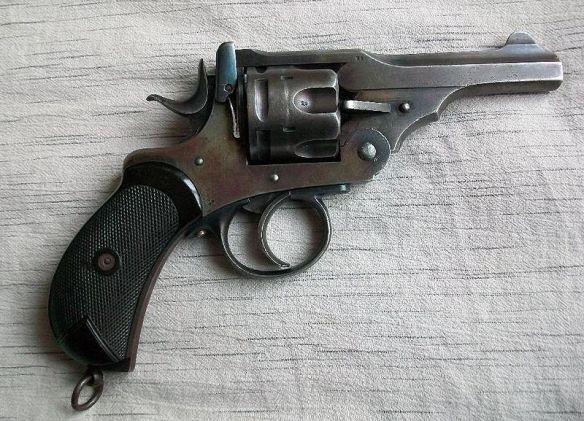(Webley Mk I, 1887) Caliber: 0.455 in (11.6 mm) Ammunition: 0.455-in 8M Ball Weight: 0.99 kg (2 lb 3 oz) Length: 260 mm (10.25 in) Barrel length: 102 mm (4 in) Magazine: 6-chamber cylinder Muzzle velocity: 183 m/sec (600 ft/sec)
(Webley & Scott self-loading) Caliber: 0.455 in Ammunition: 0.455-in 8M Ball Weight: 1.13 kg (2 lb 8 oz) Length: 216 mm (8.5 in) Barrel length: 127 mm (5 in) Magazine: 7-round detachable box Muzzle velocity: 229 m/sec (750 ft/sec)
The firm of Webley & Scott started in the 1830s in Birmingham when two Webley brothers set up as makers of parts for gun locks. They combined soon afterwards and in 1853 were advertising themselves as manufacturers of percussion revolvers. These were made in several styles, including cl plain military model. With the lapsing of the Rollin-White patents, metallic cartridge revolvers were made and in 1867 the firm was lucky enough to get a contract to supply the Royal Irish Constabulary with d solid-frame revolver of remarkable durability and reliability. It was a success and was adopted by other police forces all over the empire, setting an example for simplicity and robustness of its components. This feature was to remain a Webley hallmark for all their revolvers, and it made them ideally suitable for service in remote parts of the world. The RIC model went through many variants and different calibers, but the brothers were looking for improvements and were not afraid to buy other men’s ideas.
The Pryse patents for a hinged, self- extracting frame were bought in 1877 and a new line of revolvers put on to the market without delay. They were made in all calibers and all barrel lengths and formed the basis of all the military models that were to follow. The British Army adopted the Webley-Pryse model in 0.442-in (11.2-mm) caliber and called it the Webley Mark I. In 1899 the caliber was changed to 0.455-in (11.6-mm), by which time the marks had reached IV, and this version continued in service until replaced by the 0.38-in (9.7-mm) in 1932, by when it was the Mark VI. The differences between the marks of military revolver were not great, but each one incorporated minor changes, particularly in the methods of manufacture. There were alterations to the barrel length and shape of the butt, and the Mark VI could be fitted with a shoulder stock.
While the military revolvers were keeping the reputation of the company high among service users, the firm also produced large numbers of civilian models in all sizes and calibers ranging from pocket versions in 0.32- in (8.1-mm) up to long-barrelled target weapons with refined sights and hand- finished actions. The military contracts kept the firm going with long-term work, and the civilian products made a useful profit on top of that. When automatic pistols were introduced on the Continent in the late nineteenth century, Webley looked for suitable designs to manufacture. The Mars pistol was offered by Mr Gabbet-Fairfax, but was quickly dropped and they set to work on their own design. The aim was to build a military pistol and the first one, in 1903, was in 0.455 caliber. This had to be refined and development continued for the next six years resulting in the 0.32 of 1906, the 0.25-in (6.4-mm) Hammerless of 1909 and finally, in the 9-mm (0.354-in) of 1909. This last was s step in the right direction, though the two small-caliber models were made and sold in reasonable numbers. The 9 mm remained in production until 1930 and it was followed in 1912 by the first large-caliber automatic of the Webley design that saw military service. This was a powerful and heavy locked-breech pistol of rather angular appearance and somewhat finely made locking system.
It was adopted by the Royal Navy and later models were also taken by the Royal Horse Artillery, and at the same time the Royal Flying Corps, who were looking for a light automatic for the observers of two-seat aircraft, ordered a quantity with a light wooden shoulder stock. The army preferred the revolvers, and very large numbers of these were turned out during the First World War. Military revolvers ceased in 1932, when the army changed to 0.38 caliber, though civilian models have continued to be made, and numbers were produced for the Army in the Second World War.
